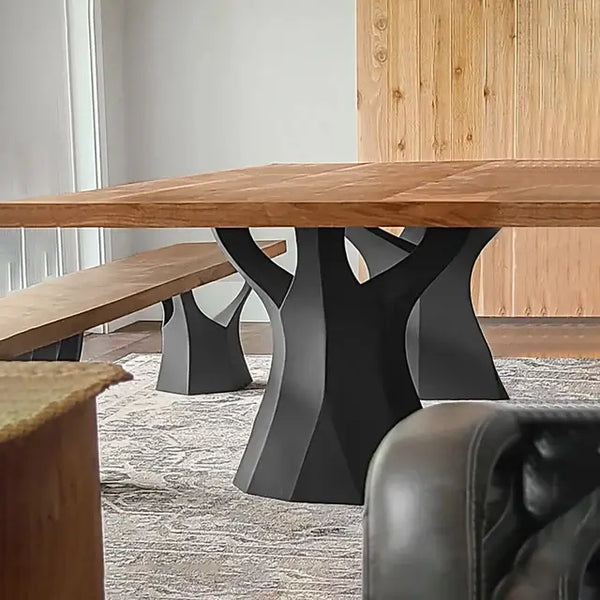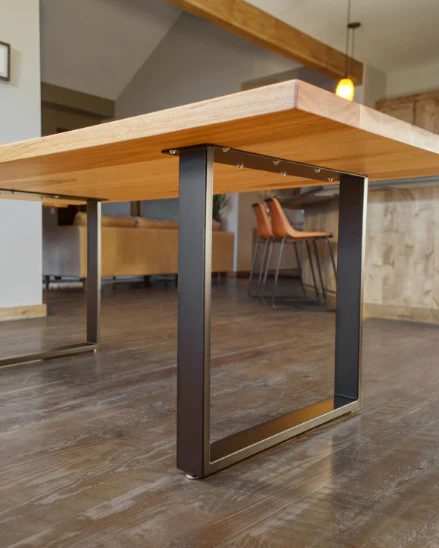Simple Steps to Replacing Old Dining Room Table Legs with New Ones
Simple Steps to Replacing Old Dining Room Table Legs with New Ones
Blog Article
From Typical to Modern: Discover the Ideal Dining-room Table Legs for Your Design
While traditional layouts such as cabriole and turned legs evoke a feeling of timeless refinement, contemporary styles like barrette and geometric options offer an opportunity for striking aesthetic passion. As you consider these components, the concern continues to be: just how can you seamlessly integrate these diverse leg styles to create a harmonious dining experience?
Comprehending Table Leg Styles
The selection of dining-room table leg designs can significantly affect both the looks and performance of the space. Each leg style contributes unique visual elements and sensible functions, providing to varied layout choices and usage requirements. Comprehending these designs is vital for picking the ideal table that aligns with your general interior layout vision.
As an example, conical legs use a tidy, traditional look that can enhance an area's beauty, while pedestal bases provide security and make the most of legroom, making them perfect for smaller areas. Hairpin legs, a characteristic of mid-century contemporary style, introduce an industrial panache, enabling an airy, open feel. Likewise, trestle legs evoke rustic charm, giving robust support and a feeling of eternity.
Furthermore, the selection of products plays a substantial duty. Wooden legs can bring warmth and appearance, whereas metal choices typically convey a smooth, contemporary ambiance. Inevitably, comprehending table leg designs is vital for creating a cohesive eating area that mirrors personal design while making sure functionality and convenience. By thoughtfully taking into consideration these aspects, you can enhance both the visual and functional charm of your dining space.
Typical Table Leg Options
When selecting dining-room table legs, typical alternatives commonly personify timeless elegance and craftsmanship. These layouts mirror an abundant heritage and a dedication to quality, making them optimal for those who value timeless aesthetic appeals.
Among one of the most iconic typical leg styles is the cabriole leg, defined by its stylish rounded form. This design usually features attractive carvings and is most frequently found in Queen Anne and Chippendale furnishings. Another preferred alternative is the transformed leg, which boasts a collection of smooth, rounded shapes that give a classic appearance while preserving stability.
Additionally, the straight leg, while basic, uses a sturdy and unadorned structure that can mix perfectly with a variety of tabletop styles. For those attracted to ornate outlining, claw-and-ball feet legs stimulate a sense of grandeur and can work as a magnificent focal factor in any kind of dining room.
Finally, stand bases, although not strictly legs, supply an alternate traditional alternative that enables sufficient legroom and can be wonderfully carved. Each of these standard leg designs adds to the total atmosphere of a dining area, marrying function with visual charm.

Modern Table Leg Designs
Modern table leg layouts use a diverse series of designs that highlight tidy lines and ingenious products. These layouts often prioritize functionality official website while working as striking focal factors within an eating area. Minimal aesthetics are widespread, with legs crafted from materials such as steel, glass, and engineered wood, which add to a contemporary and airy feel.
One prominent style is the barrette leg, identified by its slim, conical structure that provides security without frustrating the tabletop (dining room table legs). This style is often located in mid-century modern furniture and can easily enhance different eating table shapes. An additional trend is using geometric shapes, where legs may tackle unbalanced or angular forms, adding aesthetic interest and a touch of creativity

Blending Styles for One-of-a-kind Rooms
Often, property owners seek to create unique eating rooms that show their personal style by blending numerous layout elements. This strategy permits for the unification of diverse aesthetics, resulting in a harmonious yet distinctive setting. For example, combining a rustic wooden table with sleek, modern steel legs can produce an eye-catching comparison that raises the room's overall charm.
Furthermore, integrating vintage table legs with modern tabletops can stimulate a feeling of history while maintaining a modern-day perceptiveness. Such combinations not only display individual preference however additionally encourage imagination, permitting property owners to curate a space that really feels both personal and inviting.
Color plays a crucial duty in this blending procedure; choosing table legs that complement or contrast with the existing color pattern can enhance visual passion. Whitewashed legs can soften the daring of a dark table surface, producing a balanced aesthetic.
Tips for Selecting the Right Legs
Choosing the right table legs is essential for achieving both performance and visual charm in your dining area. Begin by considering the general style of your space. Typical settings profit from legs that include intricate carvings or transformed styles, while modern spaces may require smooth, minimalist designs.
Next, assess the height and stability of the legs. dining room table legs. Typical dining tables vary in between 28 to 30 inches in height, so ensure the legs match this dimension for comfort. Additionally, durable products, such as wood or steel, can enhance security and durability
Examine the leg shape as well-- choices consist of directly, tapered, or stand styles. Straight legs supply a traditional appearance, while conical legs can add a touch of beauty. Pedestal bases give adequate legroom and are ideal for smaller sized spaces.
Verdict
In summary, selecting the suitable dining space table legs requires mindful consideration of both traditional and modern-day styles. By integrating leg style, elevation, and material with the general decor, a natural and welcoming environment can be attained.
The variety of dining room table leg styles can considerably influence both the aesthetic appeals and functionality of the room. Inevitably, comprehending table leg styles is important for creating a cohesive eating area that reflects personal design while making certain practicality and see it here comfort.One of the most renowned traditional leg designs is the cabriole leg, characterized by its elegant bent form. Straight legs provide a timeless appearance, while conical legs can include a touch of elegance.In recap, selecting the optimal eating space table legs requires careful factor to consider of both modern and traditional styles.
Report this page